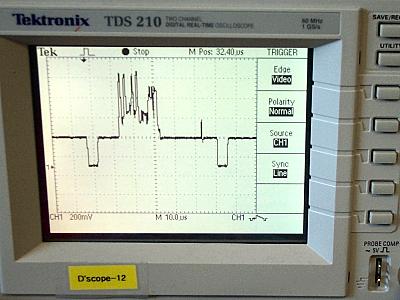
ECE 476, Cornell University
April 28, 2003
Project results
Overall, the design was very successful. The game runs smoothly, and is entertaining to play. The vector physics in the game feels accurate, and the collision detection works. The gray-scale effect works well, especially with anti-aliased graphics such as the rotated ship sprites, or the large 64-by-32 images.

black-and-white telvision signal for one horizontal line
Our video output signal is also very nice. The picture above shows our television signal, with intermediate intensities. The maximum output value was actually lower than 1V because of the resistors used for the video DAC, which were adjusted using trial and error.
The graphics do not look quite as good on a large TV when we tested it. Because we only draw every other line, the gaps between lines are much more noticeable on a big screen. Also, we were unable to fit 4 players into the game without running out of time in the frame blank. We suspect that with a little assembly conversion, we would be able to support 4 players. The part that slows it down is drawing graphics for 4 ships simultaneously. The game does, however, manage to support 3 players without problems (and no flicker). The code for a 4-player game is left intact though, should someone care to modify it to make it slightly faster or maybe overclock the Mega32 to give the extra cycles need to finish computation on painting 4 ships.
We suffered no interference with other people's designs, since our only output is to television. The design is as safe as other video games (meaning there might be a small risk of inducing seizures). The final program is quite usable as well, and the game controls are easy to pick up, partly due to our use of the user-friendly NES controller.
free to use for academic purposes.